History Of Ferrari Watches: Girard-Perregaux Pour Ferrari
In this non-chronological multipart series called “History of Ferrari Watches,” I now take a comprehensive look into the Girard-Perregaux collaboration, which took place between 1993 and 2004.
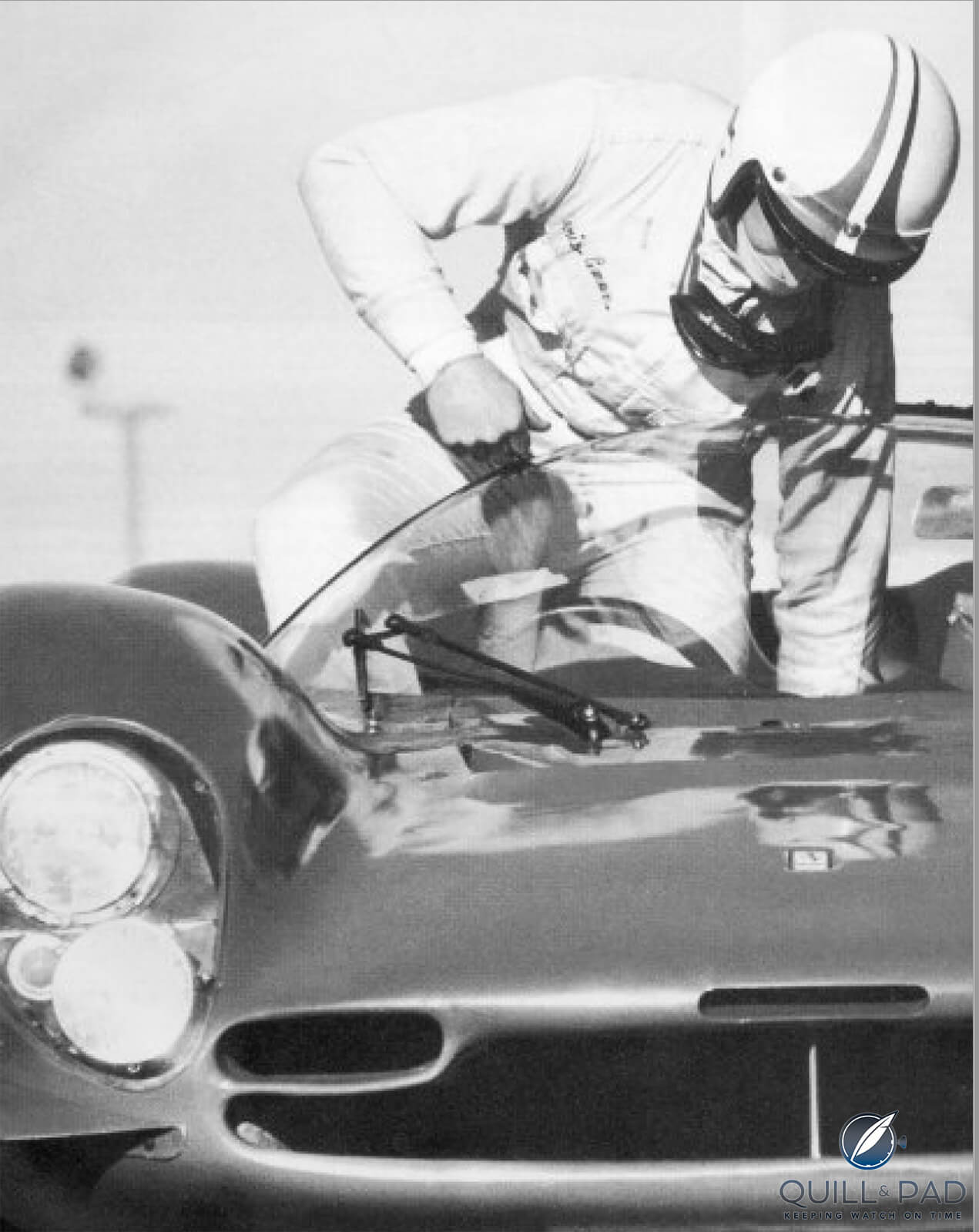
Historic racing Ferrari
Authentic roots: Luigi (Gino) Macaluso and Ferrari
Luigi Macaluso (1948-2010) – known to anyone who knew him as Gino – bought Girard-Perregaux in 1992. Nicholas Foulkes, writing about him in Mac, a book published by Rizzoli in 2020 at the behest of Fondazione Gino Macaluso, described him aptly as a polymath, a man with many interests and the ability and skill to pursue them all. His son Stefano seems to have inherited quite a bit of this too.
Which is great for this history as Stefano Macaluso agreed to talk to me at length about the Girard-Perregaux Pour Ferrari partnership that was so inextricably intertwined in Gino Macaluso’s way of reforming Girard-Perregaux.
Gino Macaluso’s personal and business interests, which included an architecture degree from the University of Turin, intersected in this extraordinary partnership with Ferrari, which started only one year after he purchased Girard-Perregaux. Here, his racing roots – among other achievements he won the 1972 European Rally Championship and the 1974 Italian Rally Championship – met his passion for his business venture, which from the mid-1970s was importing and distributing watches in Italy before he became the owner of the ailing Swiss manufacturer in 1992.
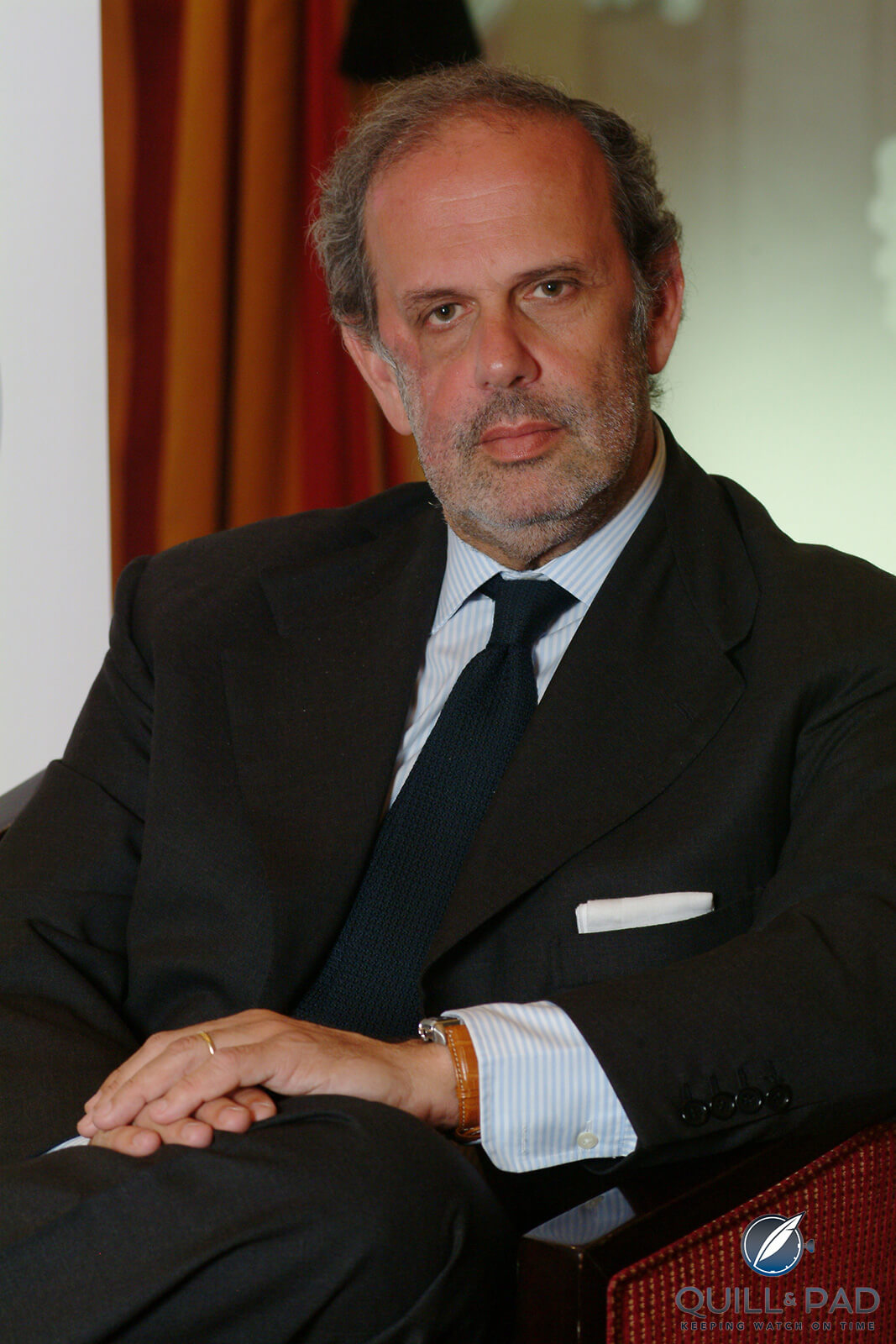
Luigi “Gino” Macaluso in 2005
The Ferrari partnership started one year later, in 1993, with a first meeting between Macaluso and Luca di Montezemolo arranged through a common friend, jeweler Gianni Bulgari. Both however had known each other since the end of the 1960s, constantly meeting at car races.
“They were both young drivers and drove with Fiat Abarth in rallies. It was a very charming Fiat Abarth 124 Spider, a fantastic car designed by Pininfarina. And they raced with this car in the first Italian, then European, then world championship and they met each other at that time,” Stefano Macaluso revealed.
Di Montezemolo, president of Ferrari from 1991 through 2014, was looking for watches worthy of the Ferrari legend, the finest in styling and technology. Beauty and performance being tantamount.
“Ferrari had had other experiences with watches, but Mr. Montezemolo liked to have more of an integrated connection, and it was really a gentlemen’s agreement between Luca di Montezemolo and Gino Macaluso,” Stefano Macaluso, who officially joined Girard-Perregaux in 2003, revealed. “They were really trustful of each other 100 percent. Mr. Montezemolo approved of every new watch, but I would say my father was really free to introduce new designs and make strategies with them. Mr. Montezemolo really was very helpful in doing this; they really had kind of a – today co-marketing sounds really like a mass-production strategy – but it was a really strong cooperation, a friendship between both and between brands. My father almost became part of the Ferrari family at the company. He also had a very good connection with Piero Ferrari, the son of Enzo Ferrari.”
The connection was so close that both di Montezemolo and Piero Ferrari wrote pieces about Gino Macaluso in Mac.
“In 1992 Ferrari still had some old watches, I think Longines, that were used as a gift rather than a real merchandising item, so I came up with the idea of talking to Gino,” di Montezemolo wrote in the chapter he authored for that book.
“We talked it over endless times at my house in the hills near Bologna! We both felt the same way, we wanted to do something different while maintaining a very high level of exclusiveness. In the meantime, he had got ahead, he had purchased Girard-Perregaux. This was a truly important initiative in terms of entrepreneurial risk because at first there were no great economic resources behind it. We started with the first Girard-Perregaux watch for Ferrari, still considered a masterpiece today.
“ . . . With Girard-Perregaux, Gino made watches that I really liked: exclusive, in limited editions. Even the great Ferrari collectors loved having these masterpieces designed to celebrate important moments: an F1 World Championship, the release of the F50, or some other special model. They were dedicated to an exclusive world, the world of Ferrari as it was then and is no longer today.”
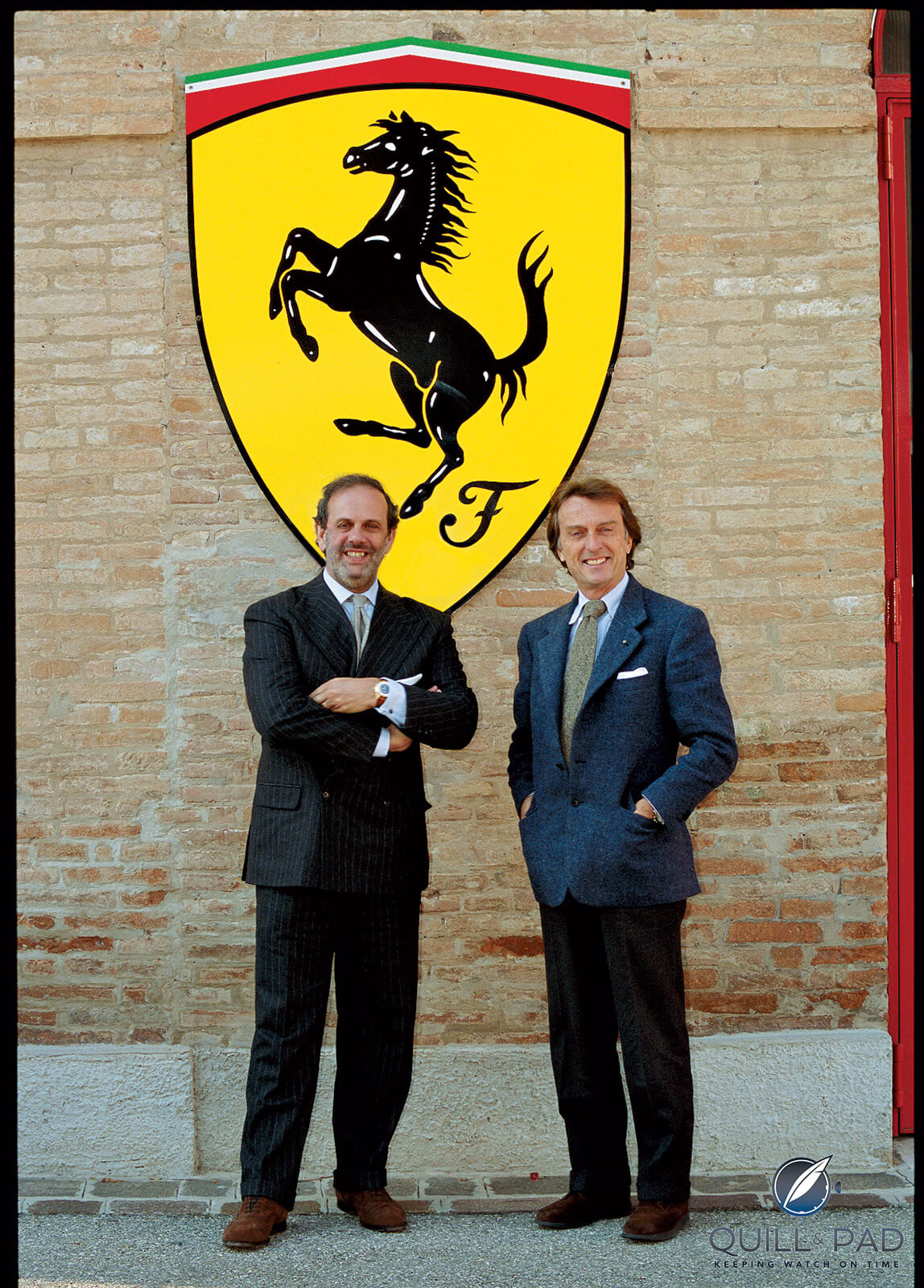
Gino Macaluso, owner of Girard-Perregaux, and Luca di Montezemolo, Ferrari president, in 1994
Macaluso and di Montezemolo decided not to bring out a “Ferrari watch” but instead crafted a very important distinction: “Girard-Perregaux for Ferrari.” This way, potential clients would be assured of purchasing a timepiece from a highly respected watch manufacture with all the quality control and service capabilities that implies.
“I think Gino managed the company image very well and made sure not to be absorbed by this partnership but used it in a versatile way,” Stefano explained. “For instance, I think it was very intelligent to introduce a new concept. It wasn’t the ‘Ferrari watch,’ it was ‘Girard-Perregaux for Ferrari.’ That was really clever because the point was that GP makes watches and Ferrari makes cars. GP didn’t make cars and Ferrari didn’t make watches – it was really a cooperation between two brands. I think people still remember the words ‘Girard-Perregaux for Ferrari’ today. And it was important because if you have a partnership that is bigger than the brand legacy itself, it will really be a problem.”
Unlike all the previous contracts between Ferrari and mid-range or high-end watch companies, this was very clearly a co-branding agreement, not simply a case of manufacturing Ferrari watches like Cartier did. Rather, the partnership was a precursor to the collaborations we routinely see today, whereby Girard-Perregaux, a prestigious watch manufacture, produced exceptional pieces for one of the most prestigious vehicle manufacturers. The difference is significant, even if generally poorly understood.
Looking back, Stefano Macaluso assured me that this collection was the most successful one Gino created for his brand. “I would say that this cooperation contributed hugely to relaunching the brand during the 1990s,” he added, alluding to the fact that when Gino had bought it the brand was somewhat down on its luck, not having come through the quartz crisis smelling like a rose.
The Girard-Perregaux Pour Ferrari collection begins
Of all the varying Ferrari watches brought out over the last 40-odd years, those that Girard-Perregaux crafted in the eleven years of this collaboration are still the ones that hold the most sway among collectors.
Stefano Macaluso revealed that the original contract was only signed for ten years and was then extended for another. But the partnership ended because his father did not want his company to be known only as the “Ferrari manufacturer.”
“We stopped in 2004 because after 11 years it was important to turn a page and focus on Girard-Perragaux itself [rather than only be] tied to the Ferrari name,” Stefano explained. “Then we moved to other partnerships: for instance, we had a very good partnership in America with BMW Oracle. This idea to make ‘Girard-Perregaux for Ferrari’ was very good in order to keep the brand itself as a pure Swiss manufacturer working for, and paying tribute to, an Italian car brand.”
It is worth noting that a ten-year contract between partnering brands is rather rare.
“I think Gino – and maybe I’m using a word here that is not totally positive in English – really exploited the concept,” Stefano continued.
“His idea was to work among or with watch collectors and car collectors. We made very few watches [at the time] and we did not sponsor Formula 1, so most of the Girard-Perregaux watches were dedicated to historical models of Ferrari, which had two good points: one was to be integrated in the nature of the classic car collector. And the second point was a very cultural connection that was very successful, but not too directly commercial. Today I think it is probably quite normal to invite a guest to car presentations or make joint events, but in the 1990s to have car collectors and watch collectors at the same event was quite avant-garde to be honest. Today it is quite normal that there’s a connection between mechanical watches and car manufacturers, but in his time it was really avant-garde.”
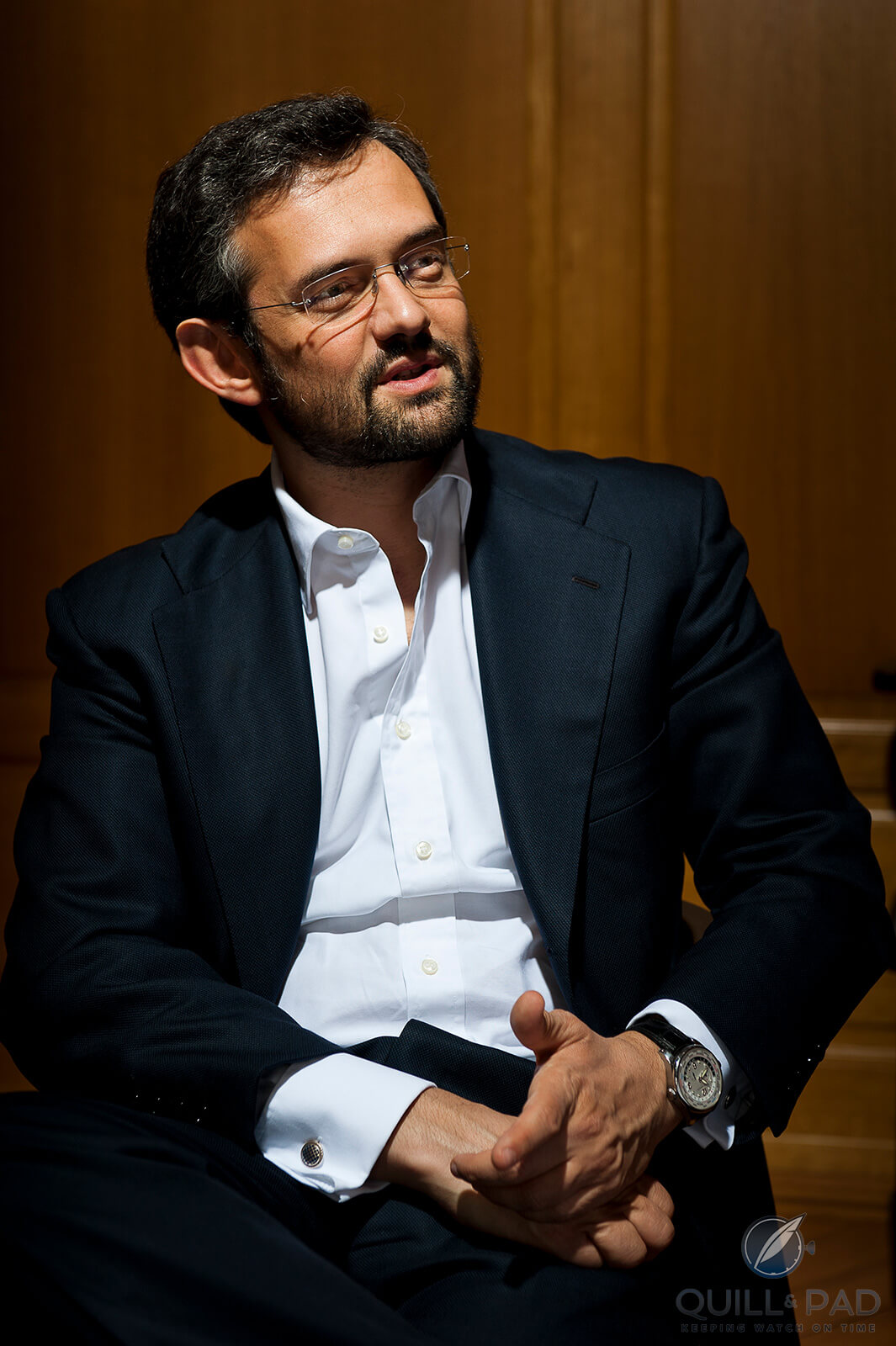
Stefano Macaluso (wearing a Girard-Perregaux ww.tc)
From the outside it was difficult to keep track of what was being created, and it turns out that was more than just an impression.
Macaluso said that, “[This collection] was quite interesting because we made a huge number of different watches and many special versions, a lot of limited editions and unique pieces – and by unique pieces I mean a different dial or a different case back and dedicated drivers and different cases as well. It was a quite large 360-degree project for GP at the time.”
When I asked if he knew how many watches and/or how many different references were made he answered quite candidly, “I think I will never be accurate about this.” Girard-Perregaux also does not have a record of every single model ever made.
“It was another time,” Macaluso admitted. “I think we introduced a kind of integrated operational system in 2004 for the first time at GP.”
Most of the watches featured both names on the dial, with Girard-Perregaux or Ferrari at 6 or 12 o’clock. But some dials may have featured only one of the brand names on the dial.
All of the cases were designed by Gino and they were different and new from anything that Girard-Perregaux had done to that point. So to note: with a couple of later notable exceptions, these were not existing watches in the Girard-Perregaux collection.
“It was a separate collection,” Stefano confirmed.
“Later we also introduced some other cases that were also from the normal collection, the Richeville, which was a tonneau-shaped case, and also the ww.tc, which was our bestselling chronograph and our bestselling watch in the year 2000. But the collection for Ferrari was housed in a round case with very rounded sides and a flat bezel and very well integrated lugs smoothly adapted to the anatomy of the wrist. I think [Gino] made hundreds of cases in order to get a good proportion in different sizes. There’s nothing more classic than a round case for a chronograph, but if you compare these round cases made by Gino Macaluso for GP with any other round case in the watch industry in the 1990s it’s totally different. I think this was a very strong contribution of Gino Macaluso in the history of watch design.
“An important point is that his inspiration was Italian with the dogma of Swiss quality and manufacturing. Which means that it was 100 percent a Swiss watch with a very deep La Chaux-de-Fonds culture for watchmaking, but the style was inspired more by Italian feeling for architecture and car design.”
So much for the preamble. My goal here is to tell the story of this partnership without listing every single watch made within it. As I learned, that is an impossibility.
Girard-Perregaux Pour Ferrari collection: 1993-1995
The first watch Gino Macaluso presented to di Montezemolo was an automatic split-seconds tricompax chronograph in a 38 mm gold case, a quite rare complication back in 1993. The prototype immediately appealed to the Ferrari head’s sensibilities, and with that the “pour Ferrari” collection was launched with Reference 9015 “Tribute to Ferrari” in a limited edition of 499 watches.
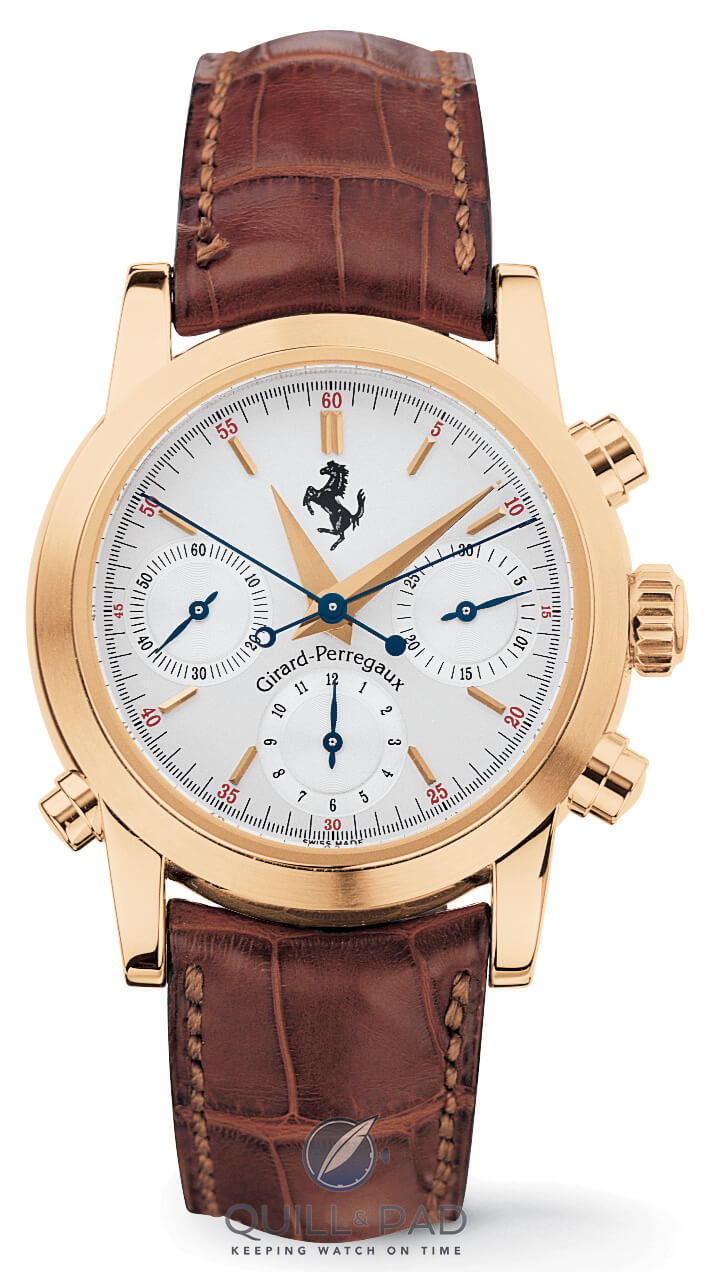
Girard-Perregaux Pour Ferrari Tribute to Ferrari Reference 9015 from 1994
While the retail price of 24,000 Swiss francs might have seemed prohibitive for the time, it did not dissuade watch enthusiasts or Ferraristi from buying it. Girard-Perregaux reports that the entire run sold out in record time.
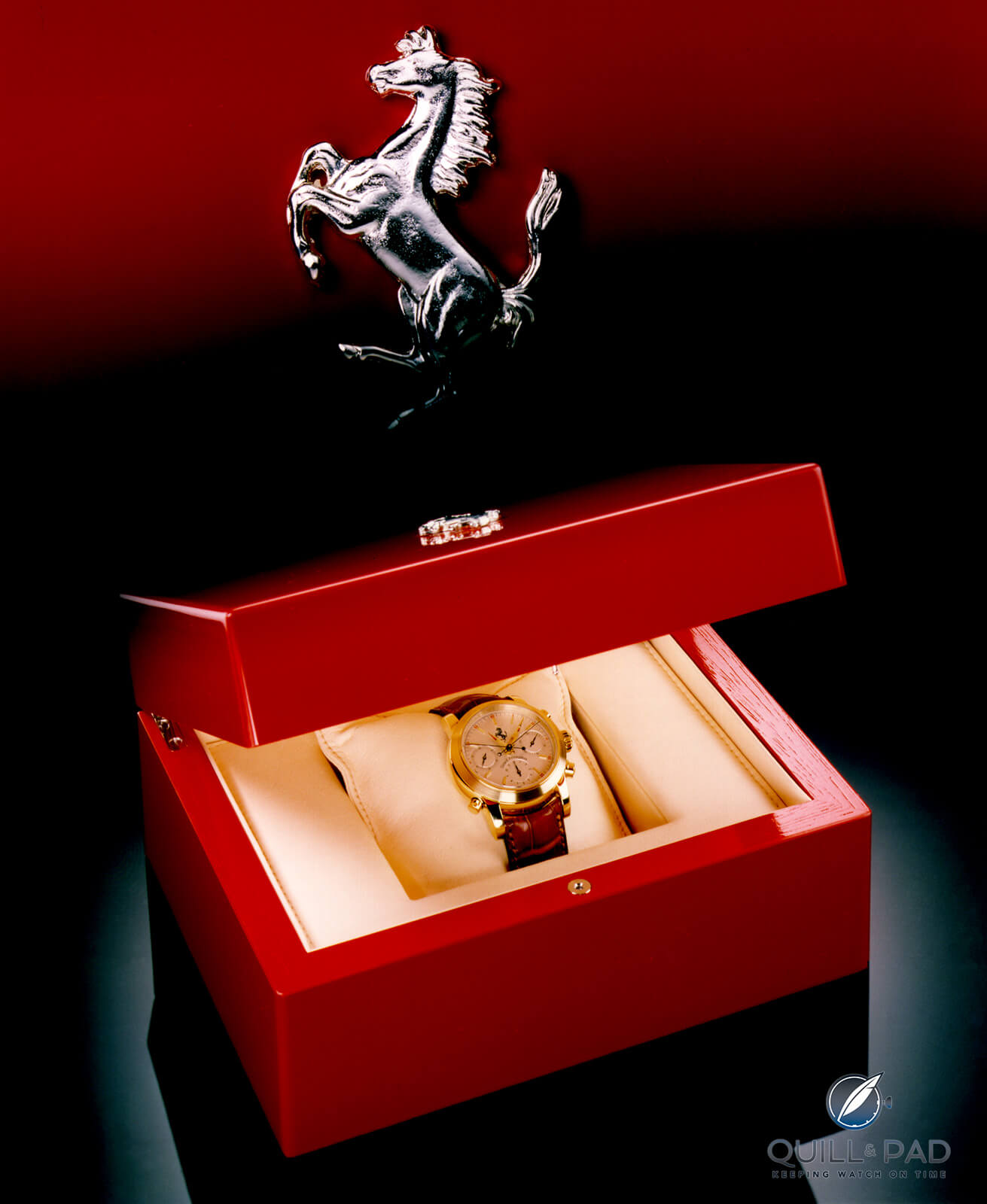
Girard-Perregaux Pour Ferrari Tribute to Ferrari Reference 9015 in its Ferrari-red box
For the celebratory launch in 1994, Ferraristi from all over the world came to the Girard-Perregaux factory in La Chaux-de-Fonds in a legendary convoy of Ferraris. “Part of the event was at the La Chaux-de-Fonds airport, too,” Stefano Macaluso, who was still a student at the time, added. “We had collectors in La Chaux-de-Fonds who also owned Formula 1 and Le Mans prototype cars. And they drove on the runway.”
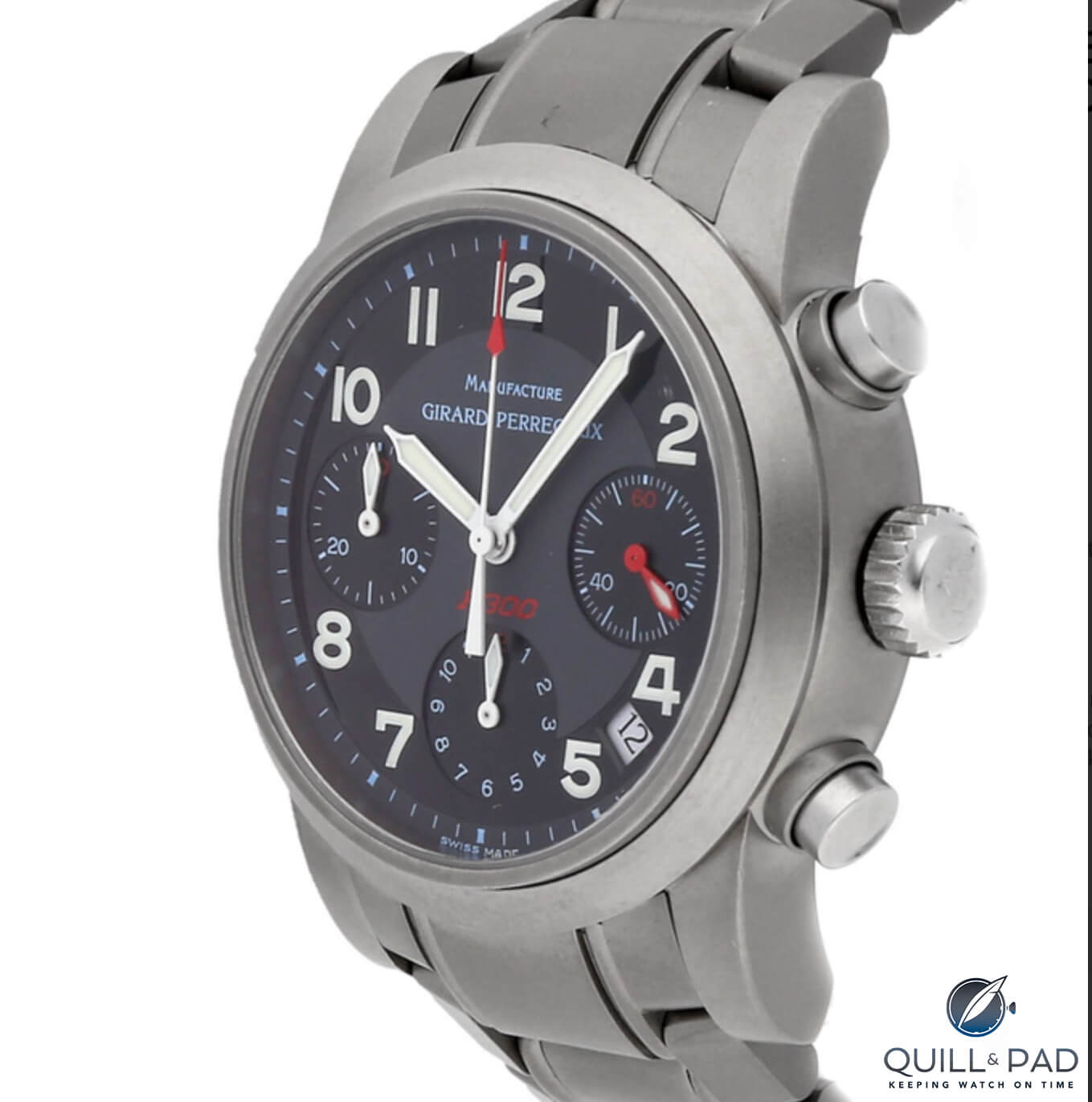
Girard-Perregaux Pour Ferrari F-300 Chronograph Reference 8020 (photo courtesy Watchbox)
From 1995, the base collection initially mainly comprised the Reference 8020 automatic chronograph and the Reference 8025 and 8030 three-hand models. The standard (less costly) collection was available in a wide array of case metals and dial colors, many of which used the typical Ferrari red and yellow tones in some capacity.
According to materials from Girard-Perregaux, Reference 8020 went on to be produced in the tens of thousands, proving to be a good way for the manufacture to boost visibility in the thick of the mechanical watch renaissance. In addition to the standard production, this reference was reissued as numerous special editions dedicated to specific cars or automotive events, as was a chronograph Reference 8090.
These standard collection pieces were largely powered by ETA and Valjoux movements, later moving to Girard-Perregaux’s manufacture movement based on Caliber GP3300.
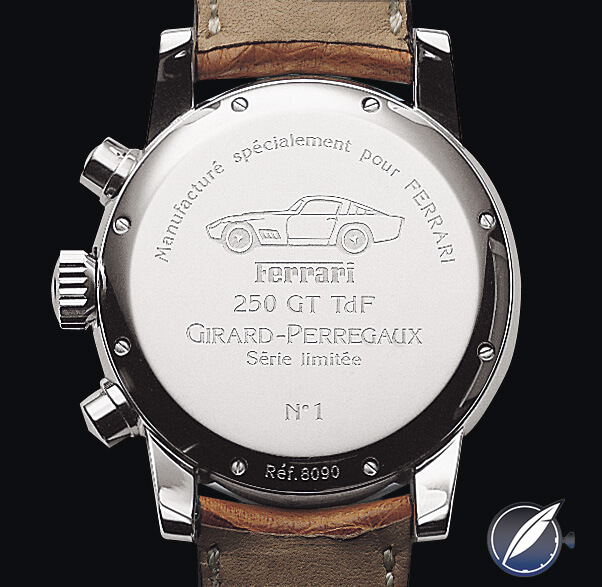
An engraved back of the Girard-Perregaux Pour Ferrari 250 TdF Reference 8090
In some markets, even some gem-set versions existed, and attention was also paid to the choice of materials, with titanium, carbon fiber, and Kevlar making appearances as case, dial, and bracelet materials.
1996: Girard-Perregaux Pour Ferrari F50 Reference 9025
Another important factor of the Pour Ferrari collection was the release of special, often highly complicated editions mainly dedicated to legendary Ferrari models. Those typically came as limited editions.
The first of these was the Pour Ferrari F50. The Ferrari F50 was the supercar of the mid-1990s, manufactured between 1995 and 1997, with only 349 cars rolling off the production line.
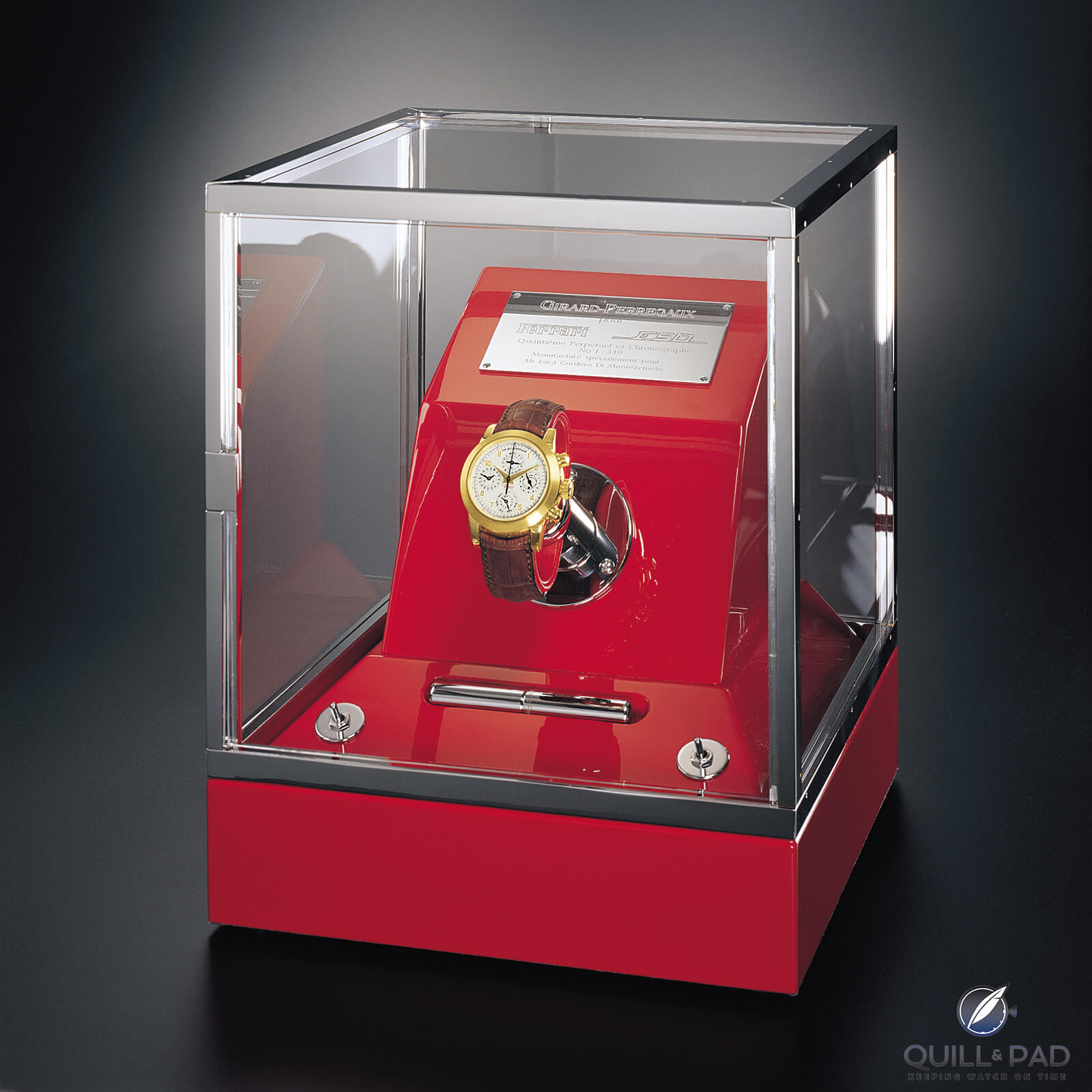
Girard-Perregaux Pour Ferrari F50 Reference 9025 in its cool box
This automatic perpetual calendar chronograph was made in conjunction with Piero Ferrari and available only in a 40 mm precious metal or titanium case. One highlight of this watch was the stunning winder box it came in, which was a Ferrari red stand outfitted with an acrylic display box, turning the watch box into a piece of kinetic art for its owner.
Like the car, only 349 pieces of this watch were manufactured, and these were made available exclusively to the lucky owners of this exceptional Ferrari, a model that some regard as the archetype of the modern supercar.
Due to significant demand from watch collectors who were not owners, a run of 250 additional pieces was later manufactured.
In 1998 Girard-Perregaux unveiled a line of automatic Pour Ferrari Lady watches, which were also graced by the Prancing Horse, among them Reference 8039, the “Lady F” Ferrari automatic, in a 29 mm case size.
1999: Girard-Perregaux Pour Ferrari S.F. Foudroyante
In general, the co-branding between Girard-Perregaux and Ferrari did not apply to Formula 1. It was out of the question for the brand to use the Scuderia logo of the F1 team. There was, however, one exception.
The year 1999 saw the release of a unique automatic chronograph outfitted with a “foudroyante” function, a jumping second counter. Girard-Perregaux, whose founder Constant Girard invented the foudroyante in 1880, is to this day famous for this type of seconds display, a lightning-fast jumping second hand that displays one-eighth of a second (if your eye can follow it).
The lightning speed – which makes up the origin of the complication’s name as foudre is French for “lightning” – of the hand is visually alluring.
The foudroyante gear wheel has the same number of teeth as the beats per second of the balance, so one full rotation of the gear equals exactly one second – which creates a blazingly fast hand that races in circles but stops completely (though not discernibly with the naked eye) with every tick.
Produced in 1999 in a limited edition of 750 pieces to celebrate the seventieth anniversary of Scuderia Ferrari, this watch was christened the S.F. Foudroyante in honor of it. The back of its case was engraved with the Scuderia logo.
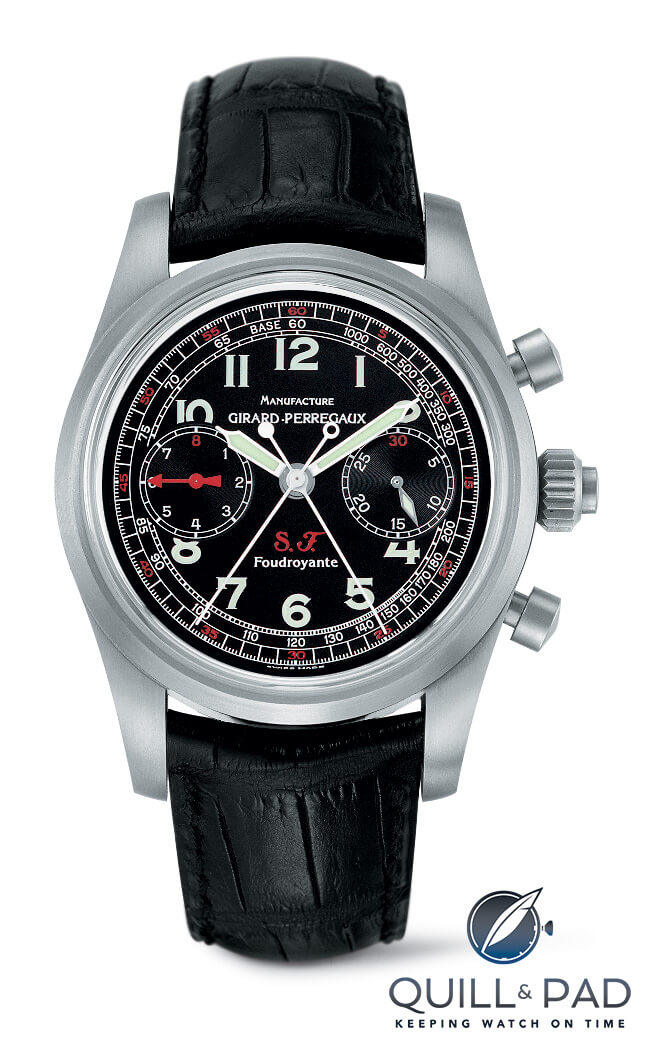
Girard-Perregaux Pour Ferrari S.F. Foudrayante Reference 9020 of 1999
The “S.F.” on the dial could stand for “seconde foudroyante” or “Scuderia Ferrari” – or both. Reference 9020 was again a split-seconds chronograph but the additional foudroyante complication really spiced it up.
Today, Reference 9020 is still considered one of the best chronograph designs from Girard-Perregaux by connoisseurs of this brand.
“[This is a watch] I love, another beautiful design by Gino Macaluso,” said Stefano.
2002: Girard-Perregaux Pour Ferrari 375 Mille Miglia Chronograph Ingrid Bergmann
I asked Stefano what his favorite watch from the Ferrari collection was, and it didn’t take him long to pinpoint it: “The watch I feel closest to is the Ferrari 375 Mille Miglia.
“The reason is very simple: that was the very first time I was involved in a project at GP because my father designed the watch. I absolutely love the design of the watch, but he asked if I had an idea about the car that would be coherent to make a tribute to the design. Probably my favorite car in Ferrari history – and it’s very 1950s in terms of style but very modern for 1950s – was this Ferrari 375 Mille Miglia made for Ingrid Bergman, which was super elegant. It was a kind of a laboratory for Ferrari because they have many new innovations with this car, with Formula 1 engineering in it, very powerful, very fast, very modern, and extremely elegant. It was very avant-garde for Ferrari at the time. And it’s a beautiful story, because it seems that the color of the car was a kind of grey, and it was chosen by Ferrari because it was inspired by the color of the eyes of Ingrid Bergman.”
This model ended up being a column wheel-controlled monopusher chronograph. Gino took the prototype to Turin, where the family still lived, and showed it to Stefano, who enthusiastically shuffled through a book on Ferrari, settling on the 375 Mille Miglia, a legendary automobile that film director Roberto Rosselini commissioned from Pininfarina for his wife Ingrid Bergman in 1954.
The car with its prestigious double signature was produced in a unique edition of one for cinema’s “it couple.” It also inspired Ferrari to mix a completely new metallic grey color: “Ingrid grey” (“Grigio Ingrid” as Stefano – and likely Ferrari – calls it) is still part of the Prancing Horse’s available color palette.
Gino and Stefano agreed that there were parallels between the car and the sensuous curves of the unusual prototype chronograph. Gino then went to di Montezemolo, who told him the 375 Mille Miglia was his all-time favorite Ferrari, giving his blessing for the watch to become part of the legend of the car. And so it became the second Girard-Perregaux Pour Ferrari model linked to a specific car.
A limited edition of 375 pieces, it came in a 31 x 47 mm pink or white gold case with square totalizers evoking Ferrari’s hideaway headlights, Reference 8050 was powered by manually winding Caliber E03C0 with a 38-hour power reserve. As far as I am aware, this movement was made by THA.
The solid case back bears an engraved profile of the car.
“I am a little proud to say that it was my suggestion about this car. I am very linked to this one,” Stefano justifiably admitted. “It was a watch we only designed for this limited special edition, and we never produced it later.”
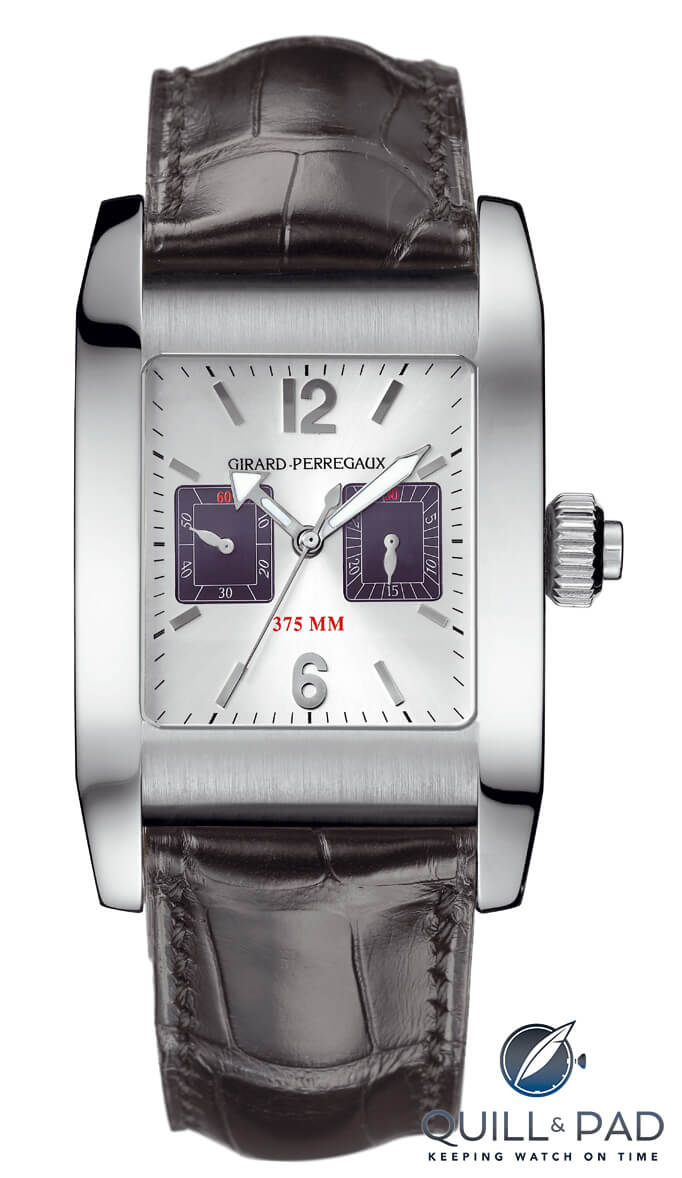
Girard-Perregaux Pour Ferrari 375 Mille Miglia Ingrid Bergman from 2002
Reference 8050, the 375 Mille Miglia Ingrid Bergmann, came in a special box that was, of course, in Ingrid Grey. And so were the dials of both variations of this watch.
Girard-Perregaux chose to unveil this exclusive model in Tribeca, New York, in November 2002, where all 375 pieces were sold in a single evening.
2003: Girard-Perregaux Pour Ferrari F2003 GA Reference 4980 (ww.tc)
An existing Girard-Perregaux model, the ww.tc World Time Chronograph, was issued in a modified version to celebrate Ferrari winning the Formula 1 World Championship in 2003.
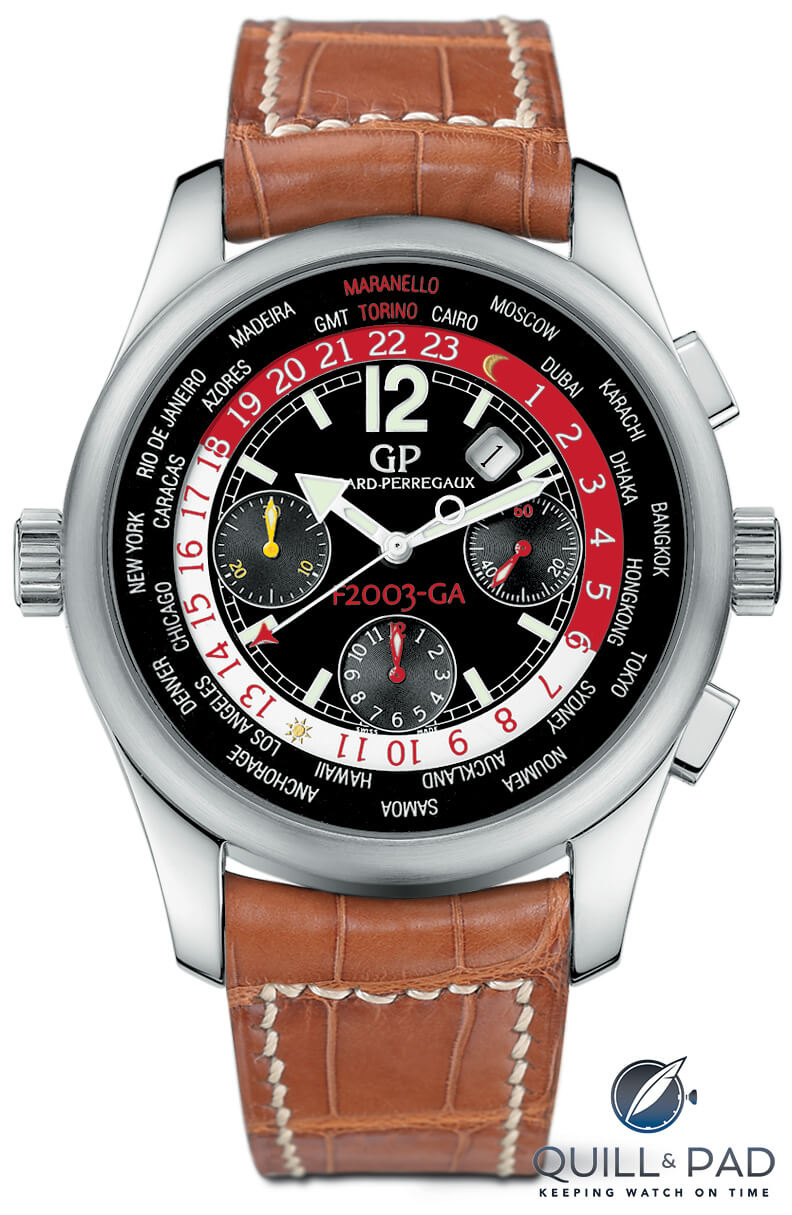
Girard-Perregaux Pour Ferrari F2003 GA Chronograph ww.tc
Like the Formula 1 car built by Ferrari that same year, it was called the F2003 GA, the initials paying tribute to Gianni Agnelli, president of Fiat (and a backer of Ferrari for 30 years), who had passed away in January 2003.
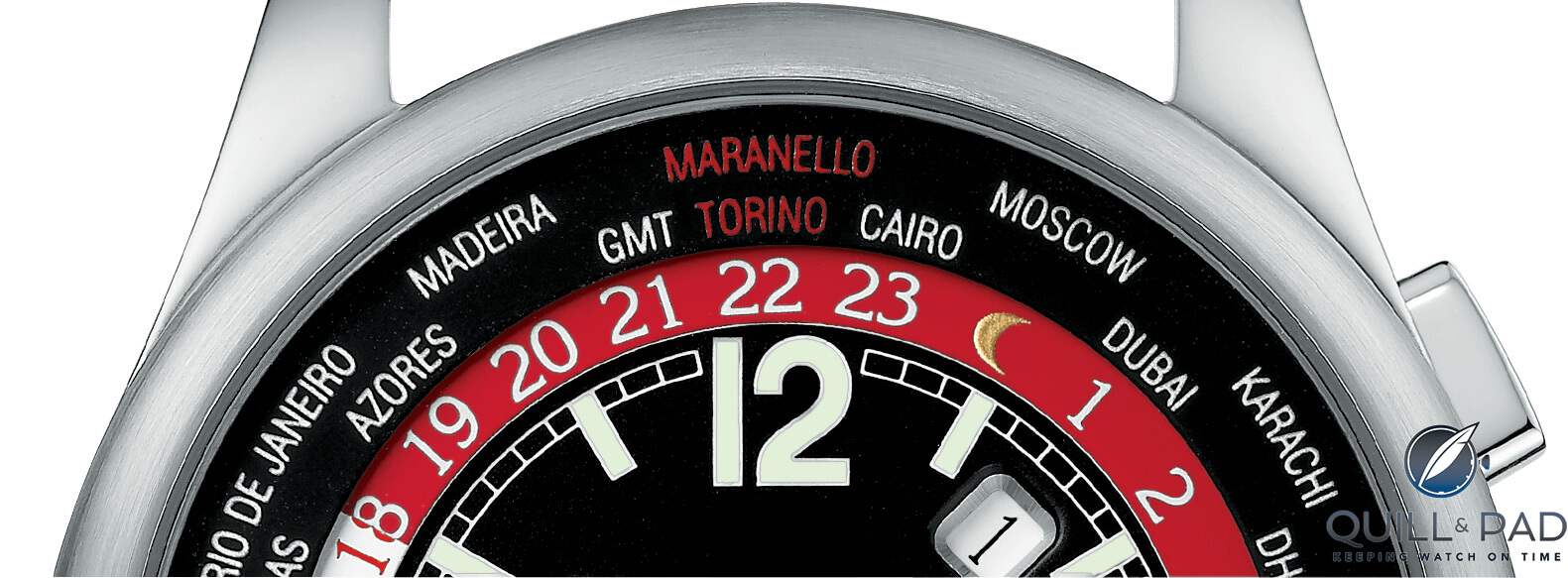
“Maranello” and “Torino” (Turin) on the dial of the Girard-Perregaux Pour Ferrari F2003 GA Chronograph ww.tc
Aside from Agnelli’s initials, the watch paid homage to both Torino/Turin (where Fiat is located but is also the Macalusos’ hometown) and Maranello (where Ferrari is located), which were both inscribed on the worldtimer’s dial to signify Central European Time.
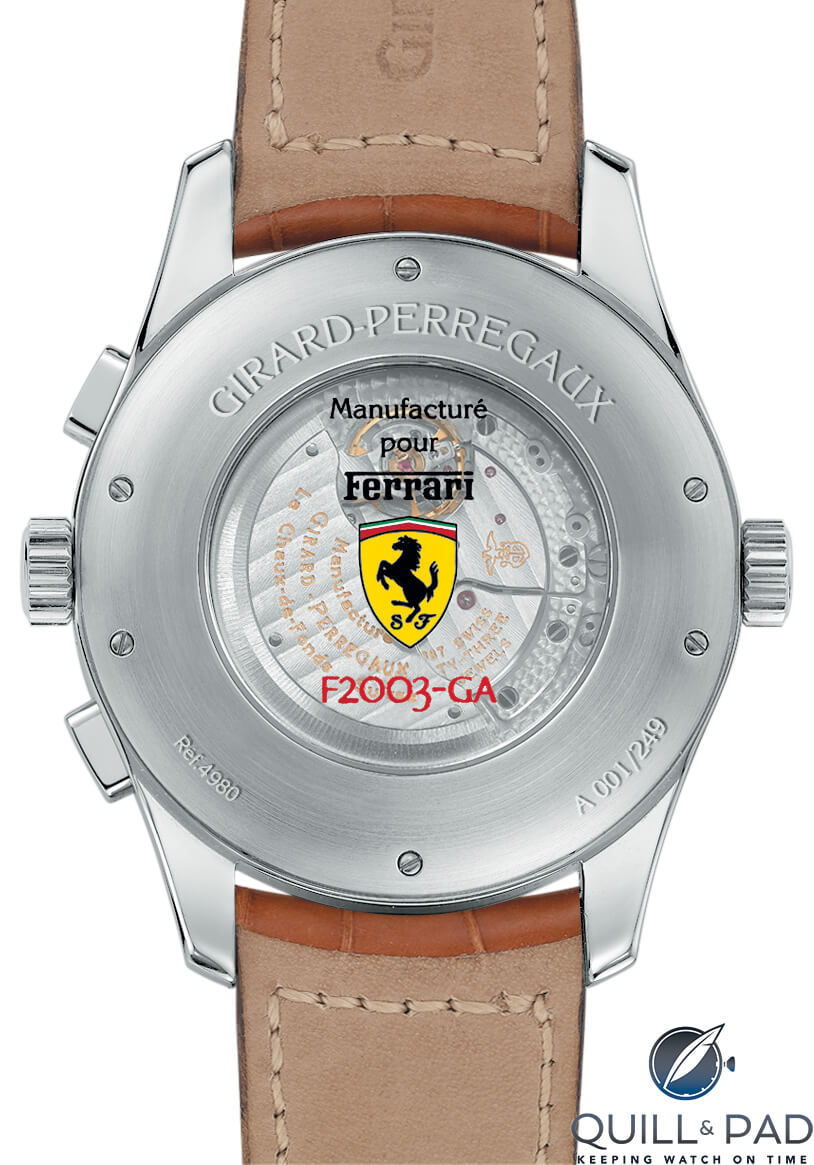
Back of the Girard-Perregaux Pour Ferrari F2003 GA Chronograph ww.tc
This 43 x 13.4 mm timepiece was powered by Caliber GP 3387, based on Girard-Perregaux’s own Caliber GP 3300 with a chronograph module by Dubois Dépraz and 24-hour module by Girard-Perregaux.
Girard-Perregaux produced 249 pieces in steel, 99 in titanium, and 25 in white gold. A similar watch in titanium was issued in a series of 100 pieces in 2004 to mark Ferrari’s first half-century in the USA.
2003: Girard-Perregaux Pour Ferrari 330/P4 chronograph
Showing the immense popularity of the Girard-Perregaux Pour Ferrari line, the Swiss manufacturer issued an enormous limited edition in 2003 in honor of Ferrari’s 330/P4 Sport Prototipo, which won the World Constructors Championship in 1967.
According to information provided by Girard-Perregaux, the 1967 series of competitions included such highly prestigious events as the 24 Hours of Daytona, 24 Hours of Le Mans, 1000 km Monza, Spa-Francorchamps 1000 kilometers (now 6 Hours of Spa-Francorchamps), and the legendary Targa Florio endurance road race in Sicily.
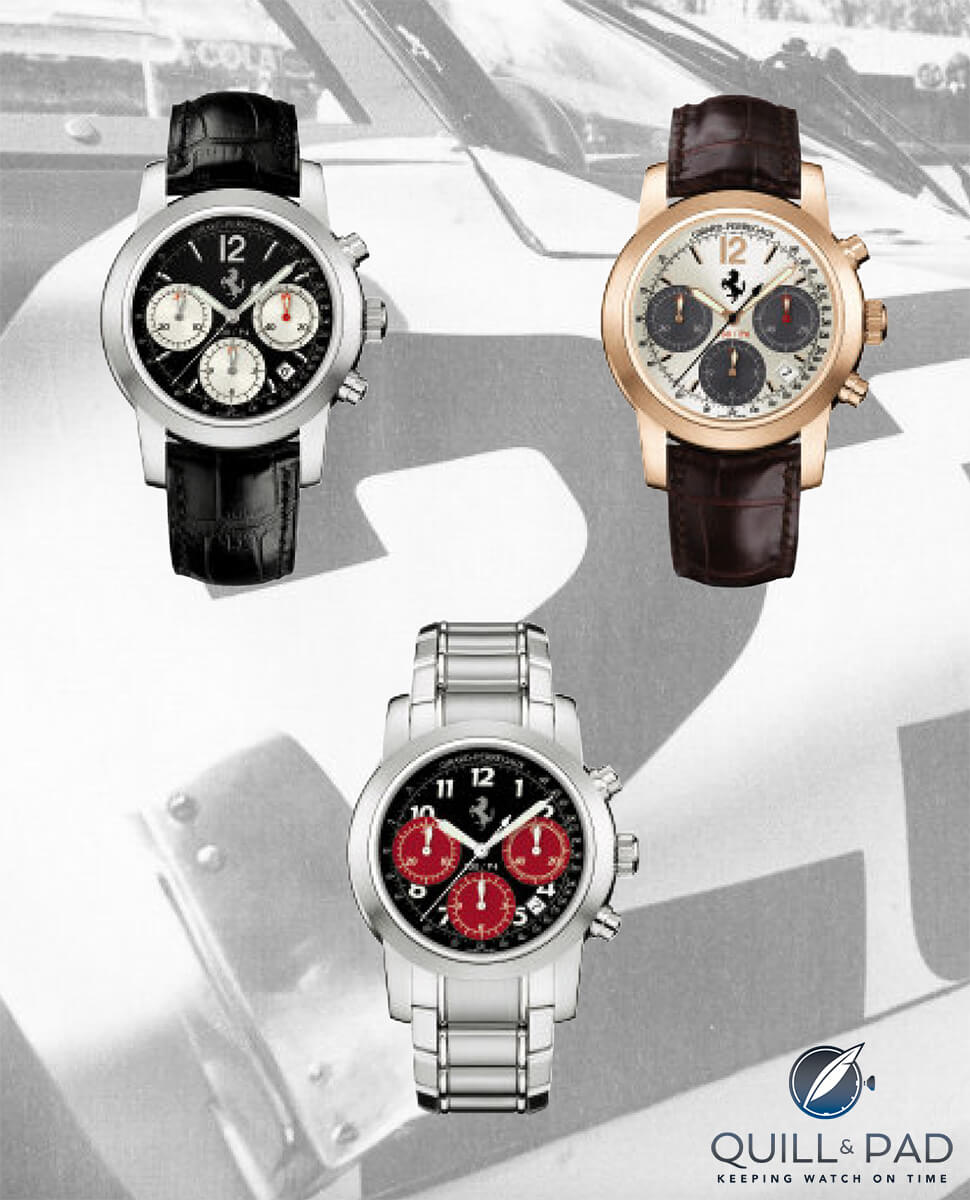
Girard-Perregaux Pour Ferrari 330/P4 chronograph collection
With the 330/P4, Enzo Ferrari was determined to confirm the competitiveness of his own cars in a trial of strength with the leading American manufacturers, who at the time were challenging the Scuderia in the World Constructors Championship. At the end of 1967, Enzo Ferrari won his bet with the P4, which took the title with triumphs at both Daytona and Monza together with high rankings in many other races.
The group of racing drivers taking their place behind the wheel of the P4 in the championship included the finest professionals and “gentlemen drivers” of the day: Chris Amon, Lorenzo Bandini, Jean Guichet, Mike Parkes, David Piper, Willy Mairesse, Pedro Rodriguez, Jackie Stewart, Ludovico Scafiotti, and Nino Vacarella.
In honor of the then 35-year-old car, This 40 x 12.25 mm automatic chronograph was released in a limited edition of 2,000 stainless steel, 250 pink gold, and 150 white gold pieces. The case back bore an engraving of the outline of the car.
It was powered by automatic Caliber 2280, based on an ETA 2892-A2 with a Dubois Dépraz chronograph module.
2004: Girard-Perregaux Pour Ferrari Tribute to Enzo Ferrari Tourbillon Reference 99190
The Girard-Perregaux Pour Ferrari collaboration’s swan song was the most interesting and definitely the most complicated watch to come from this 11-year partnership: the Tribute to Enzo Ferrari Tourbillon, Reference 99190.
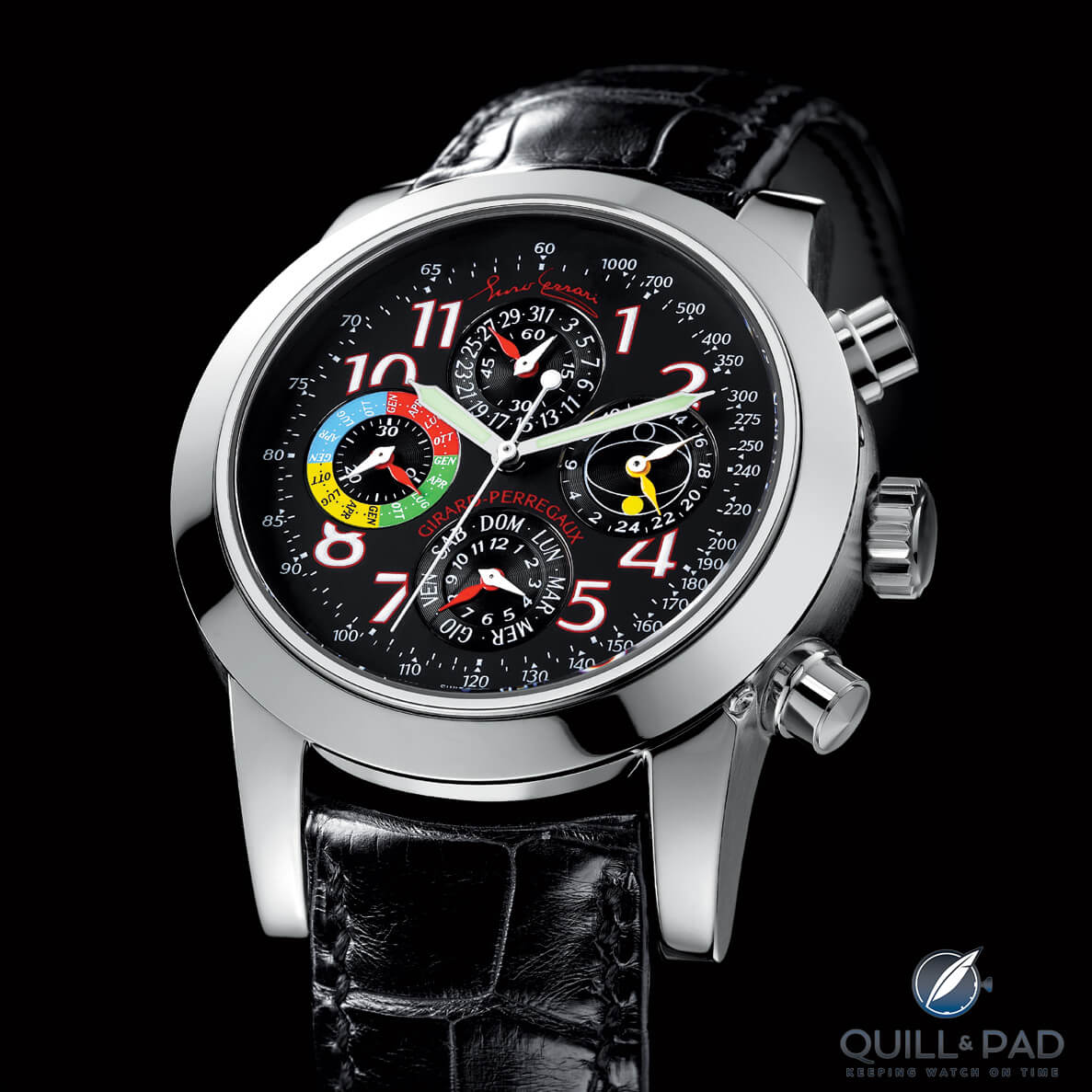
Girard-Perregaux Pour Ferrari Tribute to Enzo Ferrari Tourbillon with Three Gold Bridges Ref. 99190
In 2004, Ferrari released a truly remarkable supercar, named after “Il Commendatore” himself: the Enzo. Girard-Perregaux dedicated an equally stunning watch to him, riffing off one of its own most famous watches, the Tourbillon with Three Gold Bridges.
But this was no ordinary Tourbillon with Three Bridges: it featured both chronograph and perpetual calendar functions as well. Elements of the movement were redesigned, taking inspiration from the car’s engine, and the dial design featuring 11 hands echoed that of its dashboard. And just perhaps, I might conjecture, the 11 hands were meant to symbolize the 11 years of partnership.
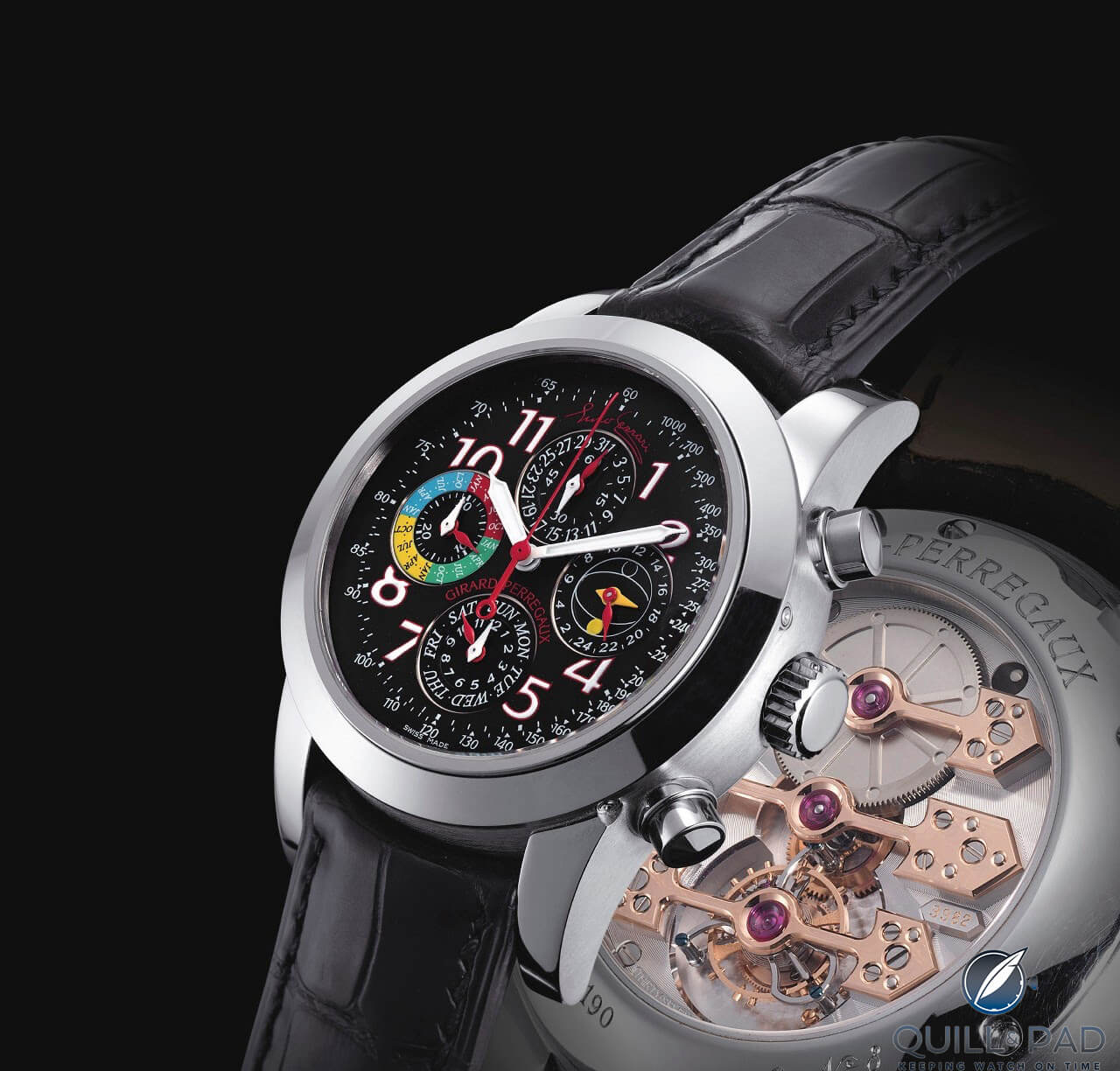
Girard-Perregaux Pour Ferrari Tribute to Enzo Ferrari Tourbillon with Three Gold Bridges Ref. 99190 front and back
As was typical for GP’s Three Gold Bridges Tourbillon back in the day, both the three gold bridges and tourbillon were only visible from the back of the watch.
I asked Stefano Macaluso what the thought process behind closing the partnership with the most complicated and most special watch of the entire collection was – was it to go out on a high note?
“The cases of the very first Tribute to Ferrari, that of the bestselling Pour Ferrari watches, and the case of the Tribute to Enzo Ferrari are probably the purest designs by Gino Macaluso. So I think the point was to close the cooperation with the same style,” Macaluso revealed. “It’s a very strange case because it’s quite unique, but at the same time it’s very classic and very modern and very comfortable. So I think it’s really the peak of his creation as a watch designer.
“The second point was the idea to close with the highest note in the 11-year production, definitely. But it was also linked with another important point: the watch was launched in Shanghai, and probably in 2004 many brands were in Chinese market, but the Chinese market in 2004 was not really developed in terms of haute horlogerie. And that was also a statement to introduce to make a big launch, to open the Chinese Market for GP with a very strong statement, with a very strong partner, and a very extreme-for-that-time complication. It was very usual in the early 2000s to see a tourbillon plus perpetual calendar and chronograph. So, it was also a good statement to open the Chinese market with a big event and a very high note for the cooperation with Ferrari and with the most iconic complication for Girard-Perregaux, which is of course the Three Bridges Tourbillon.”
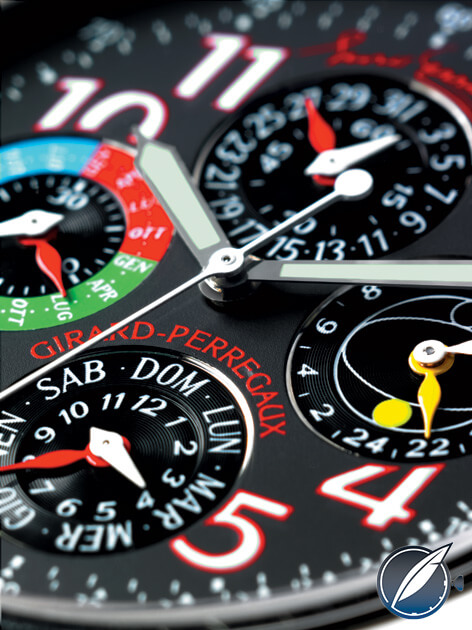
Dial details, including the day in Italian, of the Girard-Perregaux Pour Ferrari Tribute to Enzo Ferrari Tourbillon
As stated above, one of the techniques Girard-Perregaux used – a technique that is now standard practice for car/watch partnerships, but one that was then almost novel – was to correlate the design of the wristwatch to a specific vehicle. Hublot, who took over the Ferrari partnership after Panerai, did this in a masterful way.
It was the last and by far most expensive model emerging from the cooperation between Girard-Perregaux and Ferrari.
“[This is] a part of my life that’s particularly precious and I think really Gino Macaluso made strong innovations in marketing, introducing kind of a partnership that later became mainstream in watchmaking, but at his time it was really avant-garde . . . in terms of partnership between car manufacturer and a watch manufacturer,” Stefano Macaluso summed up.
After Gino Macaluso ended the partnership with Ferrari, the car maker moved on to a brand-new cooperation with Panerai, which you can see in History Of Ferrari Watches: Engineered by Officine Panerai.
You may also be interested in History Of Ferrari Watches: The Unlikely Story Behind The Cartier Formula Ferrari.
Quick Facts Girard-Perregaux Tribute to Enzo Ferrari Tourbillon Reference 99190
Case: 43 x 11 mm, platinum, white gold, or pink gold, water resistance 30 m
Movement: manually wound Caliber 9982 with one-minute tourbillon, patented three pink gold bridges, 48-hour power reserve, 3 Hz/21,600 vph frequency
Functions: hours, minutes, seconds (on tourbillon cage); perpetual calendar with day, date, month, moon phase, leap year, chronograph
Year of manufacture: 2004
Limitation: 349 pieces
Retail price at introduction: $220,000 (platinum)
Sources:
Personal telephone interview with Stefano Macaluso in May 2021
Girard-Perregaux by François Chaille, Flammarion, 2004
Mac, published by Rizzoli in 2020
Various editions of Wristwatch Annual
Girard-Perregaux press releases
You may also enjoy:
History Of Ferrari Watches: Engineered by Officine Panerai
History Of Ferrari Watches: The Unlikely Story Behind The Cartier Formula Ferrari
Sheaffer Partners With Prancing Horse To Create The Scuderia Ferrari Writing Collection
Leave a Reply
Want to join the discussion?Feel free to contribute!



There is one trouble with watch/auto partnerships. Infidelity on steroids. These supercar makers jump from bed to bed with more elan than women of the night. One day its GP, the next Panerai, the next Hublot. This isn’t a marriage; it’s speed dating.
Unsure one can consider a decade at a clip (sans Panerai) “speed dating”. 10 years—in GP’s case almost 11—is plenty of time to flex and squeeze out all one likely can from such a collaboration. Nothing lasts forever.
“In 1992 Ferrari still had some old watches, I think Longines, that were used as a gift rather than a real merchandising item”. Tend to disagree! maybe it was so, but I had seen many examples in Geneva and elsewhere and I eventually bought one in the early eighties (sold for 1000 CHF). Orthogonal shape with a quartz movement, it is a Longines watch with a Ferrari logo above six. Many different dials existed (I have two of those actually). Pictures are available in needed.
Seeing as that was a quote taken right from Luca di Montezemolo, I would not dispute that it was a fact. If someone sold some later as pre-owned, that’s a fully different story. I may take you up on your offer, thank you!
Absolutely
And don’t forget to mention that GP so far has been the one and only watch company to make a profit out of the Ferrari partnership.
From Cartier to Longines, from Panerai to Hublot – just to mention a few – all of them broke their teeth…
Good point, Roberto.
Great piece Elizabeth! -SIG
Thank you!
You are looking for one of de GPs of 125 pieces? bought in 2003, 18K white gold. All original incl. documents. Who wants to discuss or maybe got interests in it?
Hello.
Can you recommend a watch book about the brand Girard-Perregaux?
Thank you. CHRISTIAN
Can you tell me the differences between the Ferrari chronograph 1509 and the 9015?
Thank you, Bruce